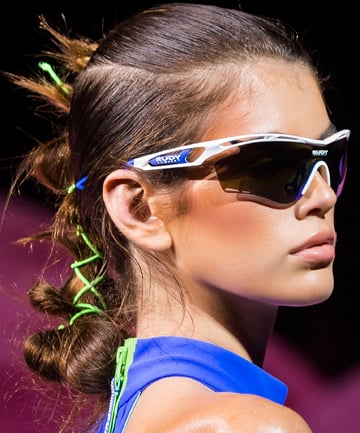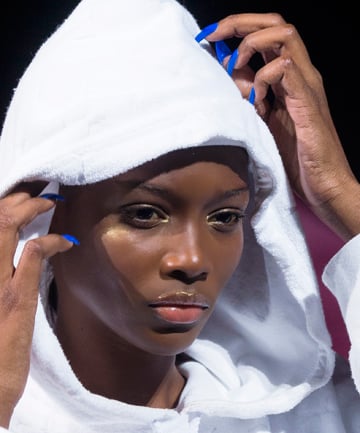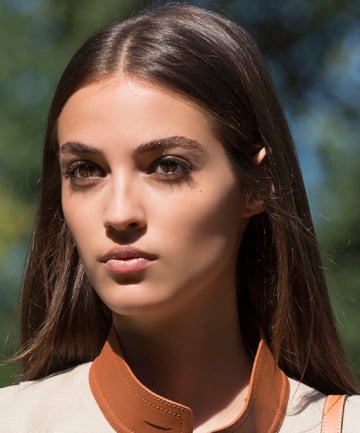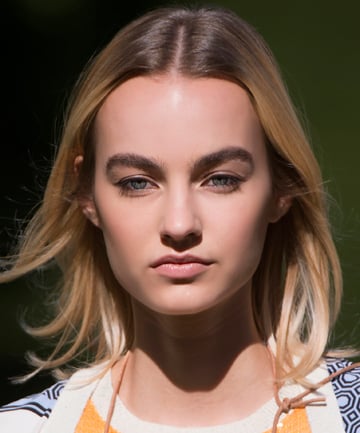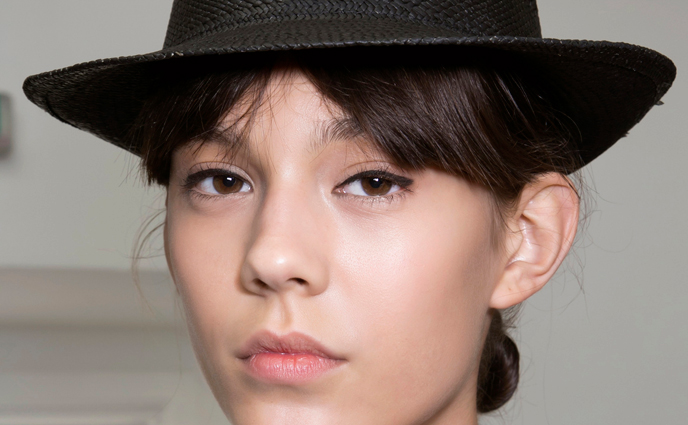"Sunscreen works in one of two ways: it either blocks the UV radiation from entering the skin like a shield, which is known as a physical sunscreen, or it absorbs the UV radiation via a chemical reaction converting it to heat, which is known as a chemical sunscreen," Levin says.
The difference between them lies in the ingredients. "Basically, a physical sunscreen is a physical blocker, which contains one of two metals that constitute a physical blocker: zinc oxide and titanium dioxide. They act as a shield on the skin and repel ions or inorganic particles that hit on the skin, reflecting UV radiation," Levin explains. "Meanwhile, chemical sunscreens create blockers that convert UV radiation into heat on the skin's surface. Which is why we say when you apply chemical blockers, to apply it 30 minutes before you go into the sun because it takes some time to take effect as opposed to a physical blocker, which just sits on your skin like a shield."
Regardless of which type of sunscreen you choose, a broad-spectrum product is what you'll want to ensure you're protected against both types of harmful UV radiation. Which means you'll want to make sure it has the right ingredients.
Image via Imaxtree
The difference between them lies in the ingredients. "Basically, a physical sunscreen is a physical blocker, which contains one of two metals that constitute a physical blocker: zinc oxide and titanium dioxide. They act as a shield on the skin and repel ions or inorganic particles that hit on the skin, reflecting UV radiation," Levin explains. "Meanwhile, chemical sunscreens create blockers that convert UV radiation into heat on the skin's surface. Which is why we say when you apply chemical blockers, to apply it 30 minutes before you go into the sun because it takes some time to take effect as opposed to a physical blocker, which just sits on your skin like a shield."
Regardless of which type of sunscreen you choose, a broad-spectrum product is what you'll want to ensure you're protected against both types of harmful UV radiation. Which means you'll want to make sure it has the right ingredients.
Image via Imaxtree
In addition to a good solid SPF, you'll want to seek out the right ingredients. This means looking for a broad-spectrum product that includes any of the following: cinoxate, titanium dioxide, zinc oxide, Parsol 1789 (also known as avobenzone), sulisobenzone and/or ecamsule. "The main thing is really UVA filters because the UVA chemical blockers are the ones that are hardest to stay stable," Levin says.
Ecamsule is one of the newest approved UVA blockers on the market and it's a dermatologist favorite. "It blocks a wide spectrum of UVA radiation and it wasn't readily available in the States for a long time," Levin says. But U.S. dermatologists fought for it and now it's available as an ingredient known as Mexoryl SX.
Levin is also a fan of another chemical blocker known as Helioplex, which is a stabilized version of avobenzone (aka Parsol 1789). "Helioplex is another chemical blocker that's kind of like a UVA stabilizer with different chemical filters," she says. Both Mexoryl SX and Helioplex are favorites of Levin.
When it comes to physical blockers, Levin says the best ingredients are metals, like zinc oxide and titanium dioxide, which act as a reflective shield against harmful UVA and UVB rays.
Image via Imaxtree
Ecamsule is one of the newest approved UVA blockers on the market and it's a dermatologist favorite. "It blocks a wide spectrum of UVA radiation and it wasn't readily available in the States for a long time," Levin says. But U.S. dermatologists fought for it and now it's available as an ingredient known as Mexoryl SX.
Levin is also a fan of another chemical blocker known as Helioplex, which is a stabilized version of avobenzone (aka Parsol 1789). "Helioplex is another chemical blocker that's kind of like a UVA stabilizer with different chemical filters," she says. Both Mexoryl SX and Helioplex are favorites of Levin.
When it comes to physical blockers, Levin says the best ingredients are metals, like zinc oxide and titanium dioxide, which act as a reflective shield against harmful UVA and UVB rays.
Image via Imaxtree
"People ask me all the time what's the best sunscreen and it's really the one you're going to use every day," advises Levin. Whether it's a physical sunscreen or a chemical one, she just wants you to use it. "I suggest broad-spectrum and that it be SPF 30 or higher. I tend to prefer a physical sunscreen for people with skin sensitivity and skin conditions like rosacea, but there are plenty of good chemical sunscreens out there that are well tolerated as well."
Now, let's talk about some best practices for sunscreen application.
Image via Imaxtree
Now, let's talk about some best practices for sunscreen application.
Image via Imaxtree
Here are some general rules for sunscreen application:
Apply enough
"That means a whole tablespoon for the face and neck, and enough to fill a shot glass to cover the entire body," Levin says.
Reapply
The most common mistake most of us make is we put it on and never think about it again. Wrong. "Sunscreens typically only last 40 to 80 minutes, so that means if you're going to be outside or outdoor activities where you're sweating, you've got to reapply. That means having a conveniently sized sunscreen bottle that you can put in your backpack or purse so you can reapply," Levin says. Even if you're just heading out for your lunch break or to run errands, if you're going outside and it's daylight (even cloudy days count), that means reapply.
Going outside? Prep before
"If you're going to be outside, apply your sunscreen like a body lotion: right out of the shower and over your entire body before you get dressed," Levin says.
Also, don't forget the "forgotten areas"
"Obviously, if your toes are going to be exposed, you want to make sure you put sunscreen between them and on your feet," Levin cautions. "There are more concerning types of skin cancers like acral letiginous melanoma (ALM), which means they're melanomas that happen on the palms and soles and can be a lot more aggressive. It's important to protect those areas people don't always think about."
It's also important to protect the ears and the scalp, which is an area where skin cancers tend to be pretty aggressive and invade more quickly. Protecting the ears and the scalp are super important, especially in men who don't typically have hair that covers their ears and may not have as much hair to cover their scalps. Same thing with women: hair thinning is a natural part of aging in both men and women. So wearing hats can be super helpful to protect the head," she adds.
Image via Imaxtree
Apply enough
"That means a whole tablespoon for the face and neck, and enough to fill a shot glass to cover the entire body," Levin says.
Reapply
The most common mistake most of us make is we put it on and never think about it again. Wrong. "Sunscreens typically only last 40 to 80 minutes, so that means if you're going to be outside or outdoor activities where you're sweating, you've got to reapply. That means having a conveniently sized sunscreen bottle that you can put in your backpack or purse so you can reapply," Levin says. Even if you're just heading out for your lunch break or to run errands, if you're going outside and it's daylight (even cloudy days count), that means reapply.
Going outside? Prep before
"If you're going to be outside, apply your sunscreen like a body lotion: right out of the shower and over your entire body before you get dressed," Levin says.
Also, don't forget the "forgotten areas"
"Obviously, if your toes are going to be exposed, you want to make sure you put sunscreen between them and on your feet," Levin cautions. "There are more concerning types of skin cancers like acral letiginous melanoma (ALM), which means they're melanomas that happen on the palms and soles and can be a lot more aggressive. It's important to protect those areas people don't always think about."
It's also important to protect the ears and the scalp, which is an area where skin cancers tend to be pretty aggressive and invade more quickly. Protecting the ears and the scalp are super important, especially in men who don't typically have hair that covers their ears and may not have as much hair to cover their scalps. Same thing with women: hair thinning is a natural part of aging in both men and women. So wearing hats can be super helpful to protect the head," she adds.
Image via Imaxtree


